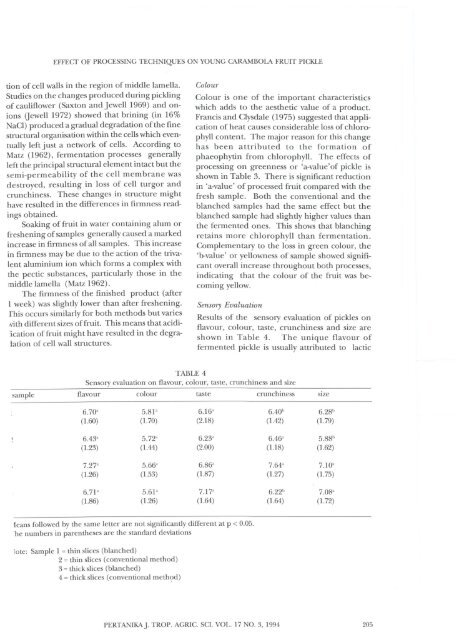Fruit Pickle
Fruit Pickle
Fruit Pickle
Create successful ePaper yourself
Turn your PDF publications into a flip-book with our unique Google optimized e-Paper software.
EFFECT OF PROCESSING TECHNIQUES ON YOUNG CARAMBOLA FRUIT PICKLE<br />
tion of cell walls in the region of middle lamella.<br />
Studies on the changes produced during pickling<br />
of cauliflower (Saxton and Jewell 1969) and onions<br />
(Jewell 1972) showed that brining (in 16%<br />
NaCl) produced a gradual degradation ofthe fine<br />
structural organisation within the cells which eventually<br />
left just a network of cells. According to<br />
Matz (1962), fermentation processes generally<br />
left the principal structural elementintactbut the<br />
semi-permeability of the cell membrane was<br />
destroyed, resulting in loss of cell turgor and<br />
crunchiness. These changes in structure might<br />
have resulted in the differences in firmness readings<br />
obtained.<br />
Soaking of fruit in water containing alum or<br />
freshening ofsamples generally caused a marked<br />
increase in firmness ofall samples. This increase<br />
in firmness may be due to the action of the trivalent<br />
aluminium ion which forms a complex with<br />
the pectic substances, particularly those in the<br />
middle lamella (Matz 1962).<br />
The firmness of the finished product (after<br />
1 week) was slightly lower than after freshening.<br />
[his occurs similarly for both methods but varies<br />
.vith different sizes offruit. This means that acidilcation<br />
offruit might have resulted in the degralation<br />
of cell wall structures.<br />
sample<br />
Colour<br />
Colour is one of the important characteristics<br />
which adds to the aesthetic value of a product.<br />
Francis and Clysdale (1975) suggested that application<br />
of heat causes considerable loss of chlorophyll<br />
content. The major reason for this change<br />
has been attributed to the formation of<br />
phaeophytin from chlorophyll. The effects of<br />
processing on greenness or 'a-value'of pickle is<br />
shown in Table 3. There is significant reduction<br />
in 'a-value' of processed fruit compared with the<br />
fresh sample. Both the conventional and the<br />
blanched samples had the same effect but the<br />
blanched sample had slightly higher values than<br />
the fermented ones. This shows that blanching<br />
retains more chlorophyll than fermentation.<br />
Complementary to the loss in green colour, the<br />
'b-value' or yellowness of sample showed significant<br />
overall increase throughout both processes,<br />
indicating that the colour of the fruit was becoming<br />
yellow.<br />
Sensory Evaluation<br />
Results of the sensory evaluation of pickles on<br />
flavour, colour, taste, crunchiness and size are<br />
shown in Table 4. The unique flavour of<br />
fermented pickle is usually attributed to lactic<br />
TABLE 4<br />
Sensory evaluation on flavour, colour, taste, crunchiness and size<br />
flavour colour taste crunchiness<br />
6.70 a 5.8P 6.16 a 6040 b<br />
(1.60) (1.70) (2.18) (1.42)<br />
6043 a 5.72 a 6.23 a 6046 a<br />
(1.23) (1.44) (2.00) (1.18)<br />
7.27 a 5.66 a 6.86 a 7.64 a<br />
(1.26) (1.53) (1.87) (1.27)<br />
6.7P 5.61a 7.17a 6.22b (1.86) (1.26) (1.64) (1.64)<br />
leans followed by the same letter are not significantly different at p < 0.05.<br />
'he numbers in parentheses are the standard deviations<br />
fote: Sample 1 = thin slices (blanched)<br />
2 = thin slices (conventional method)<br />
3 = thick slices (blanched)<br />
4 = thick slices (conventional methd)<br />
size<br />
6.28 b<br />
(1.79)<br />
5.88 b<br />
(1.62)<br />
7.lO a<br />
(1.75)<br />
7.08 a<br />
(1.72)<br />
PERTANIKAJ. TROP. AGRIC. SCI. VOL. 17 NO.3, 1994 205

















